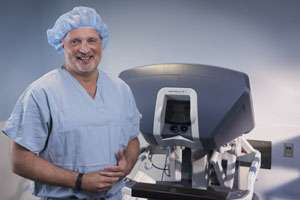Robotic surgery technique for lung cancer provides more precision, shorter recovery

Sitting at a console that looks like a video game, Gary Chmielewski, MD, is performing complex lung surgery.
The surgeon is using the console to control a four-armed robot positioned over the patient on a nearby operating table. Chmielewski operates while viewing a high-definition, 3-D image from inside the patient's body. The system translates his hand movements into precise, real-time movements of the video camera and surgical instruments that are attached to the platform's robotic arms.
Known as the da Vinci Si robotic system, the technology enables surgeons to perform complex operations by passing the robot's arms through small incisions in a patient's body. This approach enables patients to recover much faster than they would from open surgery—operations performed by hand that require much larger opening in the body.
Minimally invasive surgical procedures such as laparoscopy/thoracoscopy have become increasingly common in the past quarter century. Robotic surgery is the newest advancement in this area and combines the advantages of small incisions with computer-assisted precision, enhanced vision and improved dexterity.
"For the surgeon, the system offers better visualization and more tools to perform the minimally invasive, delicate dissection required of this kind of surgery," says Chmielewski, a thoracic surgeon and associate professor of surgery at Rush University Medical Center. "The da Vinci Si robotic surgery system is used for gynecologic, urology and other general surgeries, but thoracic surgery is one of the newest applications for the technology at Rush."
Robotics rising among lung surgery options
Fewer than 5 percent of thoracic surgeries in the U.S. are done robotically, but the technique is becoming more common as more surgeons become trained and the advantages become clear.
"In looking at the data, minimally invasive thoracoscopic surgery has been stable, robotics is growing at the expense of open surgeries, which truly is an advantage for patients as more minimally invasive chest surgeries are being done," Chmielewski says.
Rush is one of only a few institutions in the United States to offer a full range of robotic-assisted lung cancer procedures, including robotic lobectomy. The removal of a lobe (section) of the lung, lobectomy is an option for patients with early stage cancer that has not spread to other organs.
Rush also offers the two other current surgical procedures for lung cancer.
Video-assisted thoracic surgery, or VATS, involves operating through small incisions between the ribs, using an internal camera to view the surgical area. It also is a less invasive technique than open surgery, which makes recovery easier and faster. Rush is known as a leader in VATS.
Patients with more advanced cancer may require open lobectomy, which involves a long, open incision, on the side of the chest with the ribs spread known as thoracotomy. The large incision—along with spreading ribs—causes considerable trauma to the body that requires patients who undergo a thoracotomy to spend several days in the hospital, with some additional weeks for full recovery.
However, many people with early-stage lung cancer are good candidates for robotic lobectomy or VATS.
The best of man and machine
Chmielewski has experience with all three approaches. He has noted a vast improvement in the robotic technology that allows displays of the surgical field in three dimensions, with up to 10 times the magnification.
"Any motion I can do with my hands, the robot can simulate inside the patient with more precision and less tissue trauma," he says. "It all works together for a better operation that's easier on the patient."
Patients who undergo robotic lobectomy are often back to normal activities after a week. Even patients in their 80s—who are often poor candidates for open surgery—have good recoveries with robotic lobectomy.
As the use of robotic technology becomes more common, quality care will depend on the skill and experience of the surgeon and team members behind the machine.
Surgeons who adopt this technology have spent countless hours in animal and cadaver courses, intense online training, and continued practice with the simulator package that is available for use once back at their home institutions. Robotic surgeons also spend time training their operating room teams to achieve optimal results.
Robotic technology is now used at Rush for several other thoracic procedures. In addition to lobectomy, they include wedge resection, mediastinal chest tumor resections and paraesophageal hernia repairs.
Rush has several thoracic surgeons trained in robotic surgery in addition to Chmielewski, including Christopher Seder, MD, and Andrew Arndt, MD.
The team is collecting data about the outcomes of their robotic procedures to assess the results.
"I am excited to not only offer this to our patients but also to offer training to our thoracic residents who will continue to improve upon patient outcomes over their careers," says Chmielewski. "We have a strong tradition of minimally invasive chest surgery here at Rush, the addition of the robotic platform will continue to improve and expand upon this tradition."

















